You are here: Nature Science Photography – Image creation, Depth and Size – Photographic space mapping
The angle of view is of great importance for the spatial impression of a photo. It is determined by the relationship between the angle of view of the lens and the film format. The larger the angle of view of the lens (i.e. the shorter its focal length) and the larger the film format, the larger the angle of view depicted. All essential imaging properties result as a logical consequence, because the imaging process runs without the correction processes of our perception and follows the rules of central perspective alone.
Focal length Angle of view
21 mm 92°
28 mm 75°
35 mm 63°
50 mm 47°
75 mm 32°
135 mm 18°
200 mm 12°
400 mm 6°
600 mm 4°
1000 mm 2,6°
A simplified approach to this fundamental possibility of influence is the idea of projecting our surroundings onto a translucent screen standing in place of the camera, a „virtual projection screen“ so to speak. On this screen, an image of the scene based on the laws of central perspective is created. With the focal length or the angle of view of our choice, we do nothing other than pick out a more or less large piece from this projection. If this piece is large (short focal length, large angle of view), it depicts certain features that make the space appear deep to us. If, on the other hand, it is small (long focal length, small angle of view), these clues are missing.
In this regard, let us first consider short focal lengths. According to the common definition, wide-angle lenses are optics whose focal length is shorter than the image diagonal of the recording medium. In the 35 mm range, these are lenses with focal lengths of 35 mm and less. The short focal length is accompanied by a relatively large image angle and a resulting, also relatively large angle of view. Therefore, wide-angle lenses capture a large piece of space. They also have a large depth of field and a short closest focusing distance. This combination allows us to get very close to an object. Therein lies the creative key, because the more we reduce the shooting distance, the greater the angle between the vanishing lines of the objects (their parallels converging at the vanishing point), and the greater this angle is, the greater the difference in size (the perspective foreshortening) between the near and the distant objects. Near objects appear unreasonably large, distant ones unreasonably small.
The larger the angle of view of the lens, the shorter the shooting distance, and the greater the depth of the subject, the more pronounced the size difference between foreground and background.
This difference in size (see „Relative size“) between foreground and background is an indication of distance for us, and that is why we experience a pronounced spatial depth when looking at such images. The section below on the perception of object sizes will demonstrate that our vision largely ignores these size differences, as we calculate the viewing angle based on the distance. Thus, photography at this point grants us the possibility of creating a visual impression normally inaccessible to us. To make good use of this possibility, we should be quite clear about when and for what purpose we can or should use wide-angle lenses.
On the one hand, with the large angle of view we can get close to the subject and create a closeness in the image that draws the viewer immediately into the action, or simply capture the vastness of a landscape from a greater distance. On the other hand, from a normal distance, we can fully depict a narrow space, be it in a building, in nature, or where the space is constricted by many people. And, of course, we can use the high degree of perspective foreshortening to enhance an image’s message by exaggerating it. For example, we can emphasize the height of a building by increasing plunging lines or pump up the characteristic big nose of a fellow human being into caricature at close range. And of course, wide-angle lenses, just like normal lenses, are the tools of choice when it comes to handheld slow shutter speeds in low light. There is only one thing we should not abuse them for: to simply cram more and more into the picture. But no one illustrates this „don’t do“ better than the great master Andreas Feininger:
„Overloaded subjects look untidy and confusing – an unphotogenic characteristic of beginners who seem determined to cram as much as they can into a picture. They apparently cherish the belief that what is pleasing to the wandering eye must also be effective in picture form, forgetting that a picture has fixed limits; the more they squeeze into this narrow frame, the smaller and more inconspicuous everything becomes. They will only break this completely unphotogenic habit if they learn to “see photographically“ – in this context: to visually dissect a motif consisting of many details and to photograph individual parts separately.
Incidentally, this also includes the observation that almost all beginners who acquire a second lens choose wide-angle lenses that, from the same camera vantage point, capture an even wider field of view than normal lenses, thus exacerbating the unphotogenic habit of putting too much on the picture. In my opinion, they would be better advised to take a medium telephoto lens, which, because of its narrower angle of view, images everything on a larger scale and thus improves the image effect.“ (Andreas Feininger 2001)
So less is more, and limiting yourself to what is necessary is an absolute prerequisite for any successful image composition in general and the wide-angle range in particular. Five simple rules help to avoid the superfluous:
- Pay attention to the background, because a small change in shooting location often leads to big changes there when using short focal lengths
- Use foreground objects to cover superfluous backgrounds
- Use landscape and portrait formats, because they are often the easiest way to remove unnecessary elements from the picture.
- Create context, because everything that belongs together naturally deserves its place in the picture.
- Shorten the distance to the main subject, because if this is shown larger, the space for superfluous things is reduced.
Everything we have established with regard to the depth effect of the image for the wide-angle focal lengths is reversed for the telephoto lenses at the long end of the focal length scale. According to the definition presented at the beginning, we are now dealing with lenses whose focal length is longer than the image diagonal of the recording medium. In the 35 mm range, we speak of telephoto lenses from 85 mm focal length upwards. They are characterized by a comparatively small angle of view and therefore capture only a narrow range of space. This characteristic inevitably leads to a loss of the emphasis on vanishing lines that is characteristic of wide-angle lenses, so that telephoto focal lengths result in images with little foreshortening of perspective and a balanced representation of the size of near and far objects. Exactly the opposite is true of the wide-angle range: the smaller the angle of view, the greater the shooting distance, and the smaller the depth extension of the subject, the less pronounced the size gradient between foreground and background. Without the pronounced differences between the object sizes, however, we lose the important distance feature from the wide-angle range, and that is why the space in a telephoto appears to us to be of only small extent. It is also said to be flat or compressed and its individual subject planes are pressed on top of each other. It is precisely this balanced reproduction of proportions that ensures that telephoto photographs radiate a certain calm and order. The compression of space that comes with the narrow angle of view of a long focal length is accordingly only apparently present and not a property of the lens. Rather, it is already present in the image drawn according to linear perspective.
We can use these imaging characteristics to promote various aspects of image composition. First of all, there is the enlarged image of the subject, because at the same shooting distance, a lens with a longer focal length images an object larger than one with a shorter focal length (for more on the reproduction scale, see below). However, true telephoto focal lengths are not suitable for imaging small objects. Due to the lack of macro range, their maximum magnification is 1:6 or 1:10, and thus we can just take full-frame portraits. Butterflies or small bees, therefore, are out of the question. The second priority is to intentionally alter the spatial impression. There are numerous cases in which we do not want to present the subject world in the viewfinder in a wide-angle manner, but rather to take away the impression of depth and to press the foreground and background together because we want to create an abstraction. This imaging effect is useful, for example, for isolating color areas, structures and line patterns of a landscape, depriving them of their reference and thus making them easier to recognize and distinguish. The ability to create images with selective sharpness takes advantage of the fact that the depth of field decreases as the focal length increases, while the shooting distance and aperture setting remain the same. If, on the other hand, we lengthen the distance in order to keep the magnification the same, the zone of sharpness in front of and behind the focal plane is also identical at wide-angle and telephoto focal lengths. Strictly speaking, the depth of field does not depend on the focal length but on the magnification (these relationships are illustrated in detail in the chapter about visual sharpness). But be that as it may, with the well-considered placement of the focus, we direct the viewer’s gaze from the unimportant to the important, and this placement becomes easier when the optics inherently have a shallower depth of field. In addition to the effects of the small angle of view already mentioned, it is also responsible for the image having less space for the background. If it has a disturbing effect on the image composition, it can be eliminated by changing the shooting position when using a telephoto focal length. Last but not least, of course, is the distance-bridging capability that comes with the long focal length. Sports and wildlife photographers would be lost without it, as they depend on earning their bread from what is sometimes a safe distance. However, even this feature has its limits, because with increasing distance and/or decreasing subject size, every focal length is eventually exhausted. In addition, the atmospheric perspective thwarts the joy of long-distance photography on quite a few days.
Between the wide-angle and telephoto ranges lie the so-called normal lenses. Now that we have defined the focal length of wide-angle lenses as smaller than the format diagonal of the recording medium and that of telephoto lenses as larger than the format diagonal of the recording medium, you can probably guess how this factor behaves with normal lenses. Correct: The focal length of normal lenses is approximately equal to the format diagonal of the recording medium. In the 35 mm range, that’s about 45 mm. But we are generous and usually refer to 50 mm lenses as normal because their angle of view (a good 47°) roughly corresponds to what we can perceive at a glance. According to the relevant definition, this is the area that can be seen well without moving the head but with movement of the eyes. In addition, photographs with focal lengths between 40 mm and 50 mm produce images whose proportions and perspective foreshortening also roughly correspond to our visual impression. They therefore lack any gimmickry, such as the exaggeration of sizes in the foreground or an unusually large reproduction scale. For this reason, choosing the crop carefully is much more important when using normal lenses than with any other focal length. Any lack of concentration or inconsistency is particularly noticeable here, and then the pictures become boring.
The three photos shown up to this point were taken from the same location. They all show a comparable impression of space, because the proportions of the photographed objects remain the same. Only their magnification changes. The three pictures below were taken with the same lenses, but this time the shooting distance was adjusted so that the foreground object appears in the same size in each case. This changes the proportions between foreground and background and creates a different spatial impression.
Images
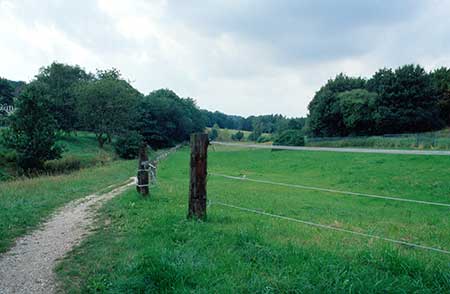
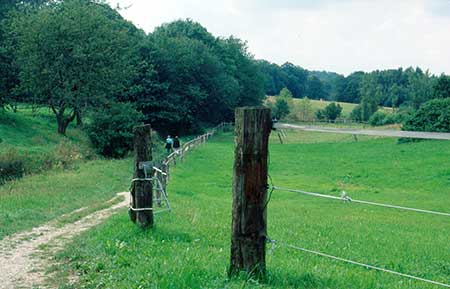
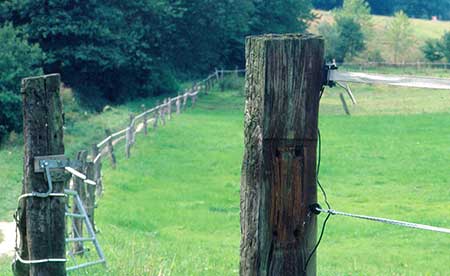


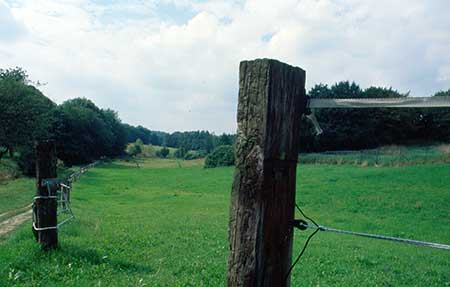
Next Direction of view
Main Image creation, Depth and Size
Previous Factors of spatial imaging
If you found this post useful and want to support the continuation of my writing without intrusive advertising, please consider supporting. Your assistance goes towards helping make the content on this website even better. If you’d like to make a one-time ‘tip’ and buy me a coffee, I have a Ko-Fi page. Your support means a lot. Thank you!


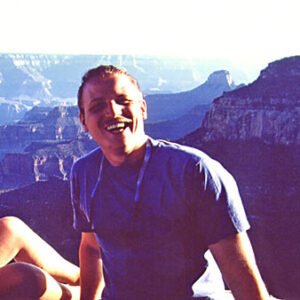 Since I started my first website in the year 2000, I’ve written and published ten books in the German language about photographing the amazing natural wonders of the American West, the details of our visual perception and its photography-related counterparts, and tried to shed some light on the immaterial concepts of quantum and chaos. Now all this material becomes freely accessible on this dedicated English website. I hope many of you find answers and inspiration there. My books are on
Since I started my first website in the year 2000, I’ve written and published ten books in the German language about photographing the amazing natural wonders of the American West, the details of our visual perception and its photography-related counterparts, and tried to shed some light on the immaterial concepts of quantum and chaos. Now all this material becomes freely accessible on this dedicated English website. I hope many of you find answers and inspiration there. My books are on